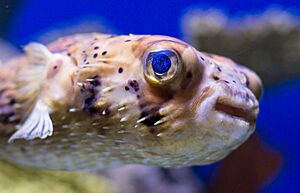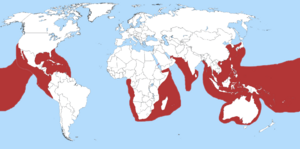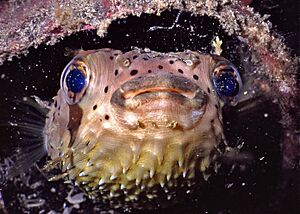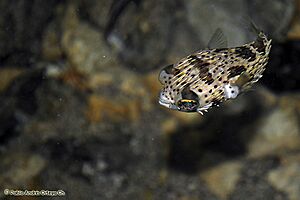Long-spine porcupinefish facts for kids
Quick facts for kids Long-spine porcupinefish |
|
|---|---|
 |
|
| Diodon holocanthus at the Audubon Aquarium | |
| Conservation status | |
| Scientific classification | |
 |
|
| Distribution of the long-spine porcupinefish |
The long-spine porcupinefish (Diodon holocanthus) is a fascinating marine fish. It's also known as the freckled porcupinefish or porcupine puffer. This fish is part of the Diodontidae family, which includes all porcupinefishes. It gets its name from the many long spines covering its body.
Contents
What Does It Look Like?
The long-spine porcupinefish is usually light in color. It has big black patches and smaller black spots all over its body. As the fish gets older, it has fewer spots.
It has many long spines, especially on its head. These spines have two roots and can lie flat against its body. When the fish feels scared, it can puff up its body. This makes its spines stand straight out, making it look much bigger and harder for predators to eat.
Its teeth are fused together, forming a strong, parrot-like "beak." This beak is very useful for eating. Adult porcupinefish can grow up to 50 centimeters (about 20 inches) long. It looks a bit like the black-blotched porcupinefish, but its spines are much longer.
What Does It Eat?
The long-spine porcupinefish is an omnivore, meaning it eats both plants and animals. It hunts for food at night. Its favorite foods include mollusks, sea urchins, hermit crabs, snails, and crabs.
It uses its strong beak to crush the hard shells of its prey. It also has special plates on the roof of its mouth. These help it to break down tough foods like mollusks and sea urchins, which would be too hard to digest otherwise.
Where Does It Live?
The long-spine porcupinefish lives all around the world in tropical seas. This is called a "circumtropical distribution." You can find them in the warm parts of the major oceans:
- In the Atlantic Ocean, they live from Florida and the Bahamas down to Brazil. They are also found in the eastern Atlantic, including around South Africa.
- In the western Indian Ocean, they swim from the southern Red Sea to places like Madagascar, Réunion, and Mauritius.
- In the Pacific Ocean, you can find them from southern Japan to Lord Howe Island. They also live east towards the Hawaiian and Easter islands. On the American side, they are found from southern California to Colombia and the Galapagos Islands.
What Is Its Habitat Like?
These fish live in many different places in tropical and subtropical seas. They can be found over muddy sea bottoms. They also live in estuaries, which are places where rivers meet the sea. You might see them in calm lagoons or around colorful coral and rocky reefs. They often hide among the rocks or corals to stay safe.
Reproduction and Life Cycle
Long-spine porcupinefish lay their eggs at the surface of the water. This usually happens at dawn (sunrise) or dusk (sunset). They can spawn in pairs, with one male and one female. Sometimes, a group of males will spawn with a single female.
The young fish, called juveniles, stay in the open water until they are at least 7 centimeters (about 3 inches) long. Both young and slightly older fish sometimes swim together in groups.






